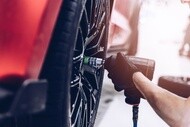
Tips & advice for car and suv tyres
Incorrect wheel alignment or wheel balancing can have consequences for your safety and the life of your tyres, resulting in avoidable costs.
In this article we will look in detail at what wheel balancing is and when it should be done. We will also look at the consequences of incorrect wheel alignment and how to fix it.
Wheel balancing
What is wheel balancing?
When we talk about wheel balancing, we are actually talking about the tyre and rim unit. A wheel can be out of balance when one area of the tyre or rim is heavier or lighter than the others. It is this unevenly distributed mass that creates an imbalance.
Wheel balancing is an intervention that aims to compensate the wheel with a mass to restore its equilibrium and make the rotation optimal.
How do wheels become unbalanced?
Often, when tyres are fitted, there is a slight imbalance in the tyre or in the wheel and these effects can actually combine to amplify the dynamic imbalance. Therefore, dynamic balancing should be carried out systematically whenever tyres are replaced or refitted.
Balancing is associated with mounting. It is systematically carried out by the professional when he or she carries out the tyre fitting for you.
Why is wheel balancing important?
If great enough, any imbalance in the wheel and tyre assembly can generate vibrations in the suspension and vehicle structure at specific speeds. Such vibrations can not only make your driving unpleasant, but also accelerate the wear of your tyre tread and other suspension components in the vehicle. Premature wear leads to increased costs as the tyre will have to be changed before its time.
Wheel balancing ensures that you will avoid the inconvenience of uncomfortable vibrations in the car and the premature expense of replacing the unevenly worn tyre.
How do I know if my wheels are out of balance?
The main signal is when you notice vibrations while driving, which cause discomfort. You may notice these vibrations in the steering wheel, the floor, the dashboard or the seats.
Imbalance is sometimes only felt when you reach certain speeds that represent natural vibrating frequencies in the suspension systems and structure of the vehicle for example.
When should I have my wheels balanced?
Balancing is always necessary when a tyre is fitted. If your wheel has been hit, for example by a kerb, the rim may have been damaged and the wheel may need to be rebalanced. If you have any doubts, have it checked by a professional.
How is the wheel balancing done?
The professional uses a wheel balancer to detect unbalanced areas of the tyre and rim assembly. He then places weights on the outside or inside of the rim, in the locations detected by the machine, to compensate for the imbalance.
- On steel rims: the professional hooks weights on the flanges of the rim.
- On aluminium rims: the professional places weights on adhesive strips behind the spokes to avoid damaging the rim.
Wheel balancing near me
If you have noticed a vibration or want to change tyres, you can find a professional near you by using our Dealer Locator.
Wheel alignment
What is wheel alignment?
Unlike balancing, which is normally about the tyre and wheel assembly, alignment is in fact about the vehicle suspension. Aligning your vehicle suspension means adjusting the wheel angles to the manufacturer's specifications. This includes adjusting the vehicle's alignment and camber, as discussed in more detail below.
This is a complex operation that must be done by a specialist.
How do I know if my wheels are out of alignment?
Uneven tyre wear or poor tyre life are signals that may indicate an alignment problem.
If you notice, for example, that the shoulder of the tyre is more worn than the rest, then it is urgent to have the alignment of your vehicle suspension checked and adjusted if necessary.
In these images, the areas of the tyre that are affected are indicated:

(1) Burr wear with protruding edges indicates a misalignment.
(2) Accelerated wear on one side of the tyre tread, inside or outside, can indicate camber maladjustment
Misalignment can lead to:
- altered vehicle behaviour, in particular poorer road holding compromising the safety of its passengers (the vehicle tends to pull to one side of the road).
- premature wear of your tyres requiring them to be replaced before their time
- excessive fuel consumption.
How does the wheel alignment go wrong?
Misalignment can occur after hitting a kerb, driving into a pothole or in more serious situations, such as accidents.
Why is it important to adjust the wheel alignment?
Properly adjusted wheel alignment helps to optimise vehicle handling and tyre life.
In addition, you save money because :
- your tyres last longer
- you use less fuel
How do I adjust the alignment of my wheels?
This must be done by an equipped professional. He makes the necessary adjustments according to the manufacturer's recommendations to optimise the vehicle's behaviour.
During the geometry check, various adjustments are checked, including parallelism and camber, which have a direct impact on the longevity of the tyres.
1/ Alignment or toe
Alignment or toe refers to the wheels on the same axle.
Left - the front wheels have a "toe-in" defect: they converge inwards.
Right - the front wheels have an "opening" defect: they are turned outwards.


Left - In countries where people drive on the left, the opposite occurs. The driver compensates by steering to the right, which wears out the right tyre prematurely.
Right - In countries where people drive on the right-hand side of the road, the inclination of the road pulls the car to the right side. The driver therefore steers slightly to the left to compensate. In this case, the tyre on the left will be worn the most.
2/ Camber
Camber is the inclination of the wheel from the vertical when looking at the vehicle from the front.
Left - On the left a negative camber.
Right - On the right a positive camber.

If this angle is too large, the tyre will wear unevenly.
- Positive camber is when the top of the wheel moves away from the vehicle. Excessive positive camber wears the tyre on the outer edge.
- Negative camber is when the top of the wheel is tilted towards the inside of the vehicle. Excessive negative camber wears the tyre on the inside edge.
The camber angle is studied and adjusted for each vehicle in order to keep the tyre as flat as possible on the ground in straight lines and in corners. If there is too much difference in camber angles between the front wheels, the vehicle will tend to pull sharply to one side.
When should I have my wheel alignment checked?
It is recommended that you have your wheel alignment checked when you notice uneven wear in your tyres, if you detect any change in the handling or steering and when you have new tyres fitted.
Tyre wear is checked during the vehicle's technical inspection. If abnormal wear is noted by the technician, he may advise you to have the alignment checked.

Wheel alignment near me
You can use our dealer locator: it will help you find a tyre specialist nearby.

Find a professional near you for your wheel balancing or your wheel alignment
Search by
Address, City or ZIP code
Car
Locate me
Top 5 cities in Africa

